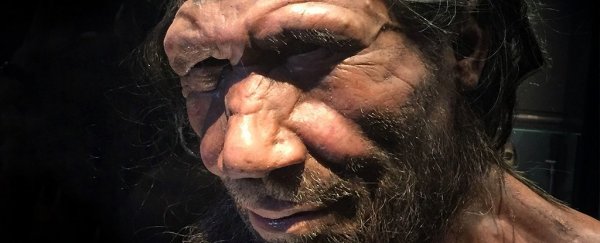A 52,000 year old splinter of bone uncovered in a Croatian cave has provided researchers with new insights into our connections to our closest extinct cousins, the Neanderthals.
The specimen was analysed to provide a rare example of a near complete Neanderthal genome, helping confirm several hypotheses on their evolution while forcing us to reconsider how much of our close cousin's genome we share.
Decoding Neanderthal DNA almost feels like old news. In 2010 researchers drilled into 44 small bones uncovered in Vindija cave in Croatia's far north, in search of Neanderthal DNA.
They came away with the first complete sequence of a Neanderthal genome, setting a landmark event in genetics and the study of human history.
More success in 2014 in the Altai Mountains of Siberia, with an even better 122,000 year old specimen providing a complete sequence of a Neanderthal woman. From her genome researchers compared the relationships between modern humans, Neanderthals, and another of our close cousins called the Denisovans.
The Altai specimen's genes also suggested as much as 2.1 percent of the DNA in modern Europeans and Asians could have come from great-grandpa and great-grandma Neanderthal.
As significant as these discoveries were, researchers from the Max Planck Institute for Evolutionary Anthropology wanted to know if improvements in technology might help them get more from the Vindija bones, sending them back to the specimens for fresh samples.
One bone – code named Vindija 33.19 – proved to be a treasure trove.
Stitching together the jigsaw puzzle of DNA fragments they managed to sequence, the researchers were able to construct a second complete, quality Neanderthal genome from a single individual.
With the sum of research combined, anthropologists now have a clearer picture on the age-old love affair between Neanderthals and the direct ancestors of today's European and Asian populations. Similar to what was revealed in previous studies, Vindija 33.19 came from a population that was about 3,000 in size.
The Altai genome contained hints that the parents were half-siblings, raising questions on how incestuous Neanderthals might have been. Yet Vindija 33.19 shows no sign of her parents being closely related.
Living in Europe nearer to the time when humans were first venturing out of Africa, her DNA provides us with a stronger indication of what kinds of genes they shared with modern human groups.
It turns out European and Asian DNA could be as much as 2.6 percent Neanderthal.
The study also provided evidence of Neanderthals and modern human ancestors mingling between 130,000 and 145,000 years ago, before the Croatian and Siberian Neanderthals split up.
That puts it more in line with evidence pulled from scraps of DNA extracted from a Neanderthal leg bone that suggested humans were already venturing into Europe about 124,000 years ago.
The kinds of genes Vindija 33.19's relatives passed our way have an effect on things like our blood cholesterol levels, various eating disorders, the accumulation of fat around our gut, responses to antipsychotic drugs, and our development of conditions such as rheumatoid arthritis and schizophrenia.
A separate study, also conducted by the Max Planck Institute for Evolutionary Anthropology, recently found Neanderthal genes in modern humans could also influence our skin tone and hair colour, sleep patterns, our moods, and even our risk of nicotine addiction.
With future advances in extraction and sequencing technology, and possible new discoveries, it's almost certain the rough numbers we have describing our occasional Neanderthal booty calls will continue to be fine-tuned, providing deeper insights into our shared heritage.
For tens of thousands of years our stocky cousins wandered the continent, adapting to new climates and settling in exotic new lands. It's been about 30,000 years since the last of the Neanderthals passed away.
The Neanderthals might be long gone, but their legacy lives on in many of us today.
This research was published in Science.
